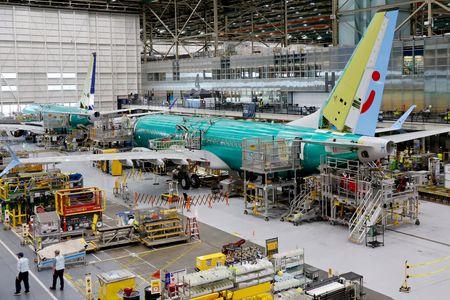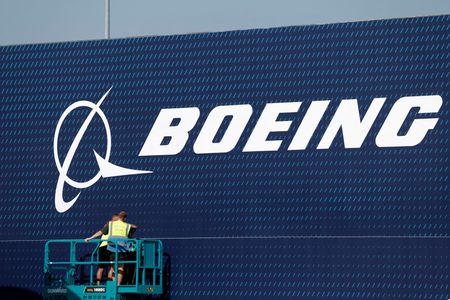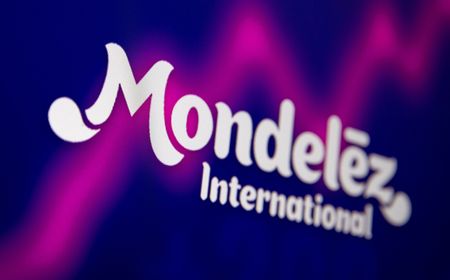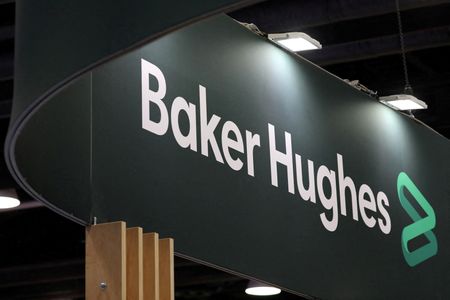By Dan Catchpole and Shivansh Tiwary
(Reuters) -Boeing’s quarterly loss more than halved and was much smaller than analysts expected as the U.S. planemaker ramped up jet deliveries, recovering from a regulatory crisis and a major strike that halted most production last year.
The results highlighted Boeing’s efforts to cautiously increase monthly output this year, following years of quality issues and production delays on its flagship 737 MAX. Increased deliveries mark a pivotal step in Boeing’s effort to rebound from years of production disruptions and crises that piled on debt, increasing the urgency of accelerating output to restore financial stability.
Boeing shares closed down 4.4% on Tuesday.
The drop was “surprising” and unwarranted based on the quarterly results, Barclays Capital aerospace analyst David Strauss said in a note to investors.
The company’s financial improvements were tempered by its announcement that certification of the 737 MAX 7 and 10 models will not happen until 2026, another setback for those programs. The company previously said it expected to finish certification by the end of this year.
The company is still developing solutions to address problems with the 737 MAX models’ engine de-icing systems that are stalling certification, which is proving a “little more tricky” than anticipated, Boeing CEO Kelly Ortberg told CNBC.
During the interview, he praised President Donald Trump’s aggressive use of tariffs to hammer out trade deals.
“I like the way this tariff situation is playing out,” Ortberg told CNBC. “It’s good for our business, is good for aerospace,” and will create jobs in the United States.
The U.S. and EU agreed to exempt aircraft and aviation parts from tariffs. However, raw materials such as steel and aluminum remain subject to steep duties.
The planemaker posted an adjusted core loss per share of $1.24 for the quarter through June, compared with a $2.90 loss a year ago. Analysts had expected a loss of $1.48 per share.
The planemaker’s free cash flow usage, a key metric for Wall Street, was better than expected, signaling an improving cash position.
“As we continue to execute our Safety & Quality Plan, there’s more stability in our operations,” Ortberg said in a letter to Boeing employees.
Boeing’s commercial plane division will lose money through the year, but free cash flow looks to be positive by year-end, Boeing Chief Financial Officer Brian West said during a call with analysts.
In May, the company produced 38 737s and production has been stable since then, according to Boeing.
The company expects to shut down its 737 shadow factory in Moses Lake, Washington, which supports its main production lines, by the end of the year, West said.
CAPPED PRODUCTION
The U.S. Federal Aviation Administration capped the production of Boeing’s best-selling 737 MAX jets following a mid-air panel blowout in a nearly new jet in January 2024.
“We plan to seek FAA approval to increase to rate 42 when our key performance indicators (KPIs) show that we’re ready,” Ortberg added.
The agency will review Boeing’s supply chain before allowing a rate increase, FAA Administrator Bryan Bedford said last week. He called Boeing’s efforts to improve production quality “real” but “embryonic.”
Boeing delivered 206 737 MAX jets through the first half of the year, compared to 135 a year earlier. Across all commercial jet programs, it delivered 285 airliners through June, compared to 175 during the same period in 2024. Wall Street closely tracks aircraft deliveries because planemakers collect much of their payment when they hand over jets to customers.
Boeing also increased 787 production at its plant in Charleston, South Carolina, from five aircraft a month to seven. The company expects to deliver more than a dozen 787s that have been delayed due to supply-chain problems, West said.
Through the first half of the year, the planemaker booked 668 orders, or 625 net orders after cancellations and conversions.
In May, Boeing’s defense, space, and security division resumed deliveries of its KC-46 aerial refueling tanker to the U.S. Air Force, after finding cracks in at least two new aircraft this year. The company started ground testing of the MQ-25, a refueling drone ordered by the U.S. Navy, during the quarter.
Members of the machinists union at the defense division overwhelmingly rejected a four-year contract offer on Sunday. The union represents 3,200 Boeing employees, mostly in the St. Louis area. If negotiations stall, union members could approve a strike as soon as Sunday.
A strike would be much smaller than the one Boeing endured last fall, when 33,000 machinists at Boeing’s commercial plane division walked out for nearly two months.
“We’ll manage through this,” Ortberg said during the call.
The division earned an operating profit of $110 million, compared with a loss of $913 million a year ago.
It reported free cash flow usage of $200 million for the second quarter, compared with analysts’ expectations of $1.72 billion, according to data compiled by LSEG. Boeing burned $2.3 billion in free cash during the previous quarter and $4.33 billion during the second quarter of 2024.
Revenue for the quarter rose 35% to $22.75 billion, beating analysts’ estimates of $21.84 billion.
(Reporting by Shivansh Tiwary in Bengaluru and Dan Catchpole in Seattle; Editing by Saumyadeb Chakrabarty and Rod Nickel)









